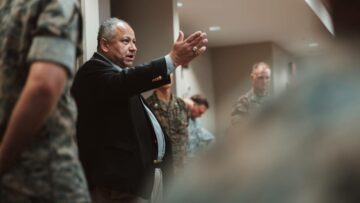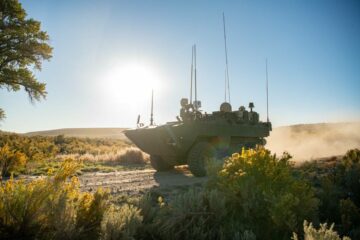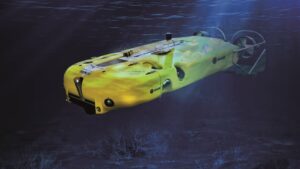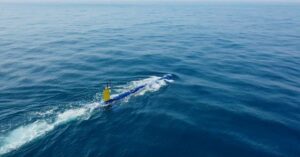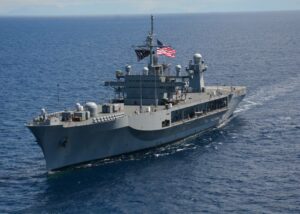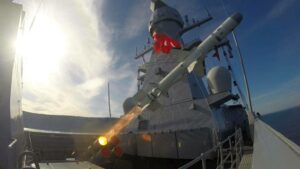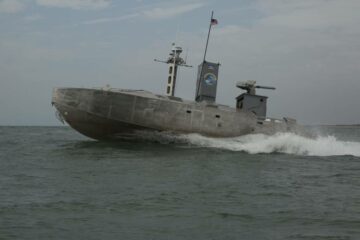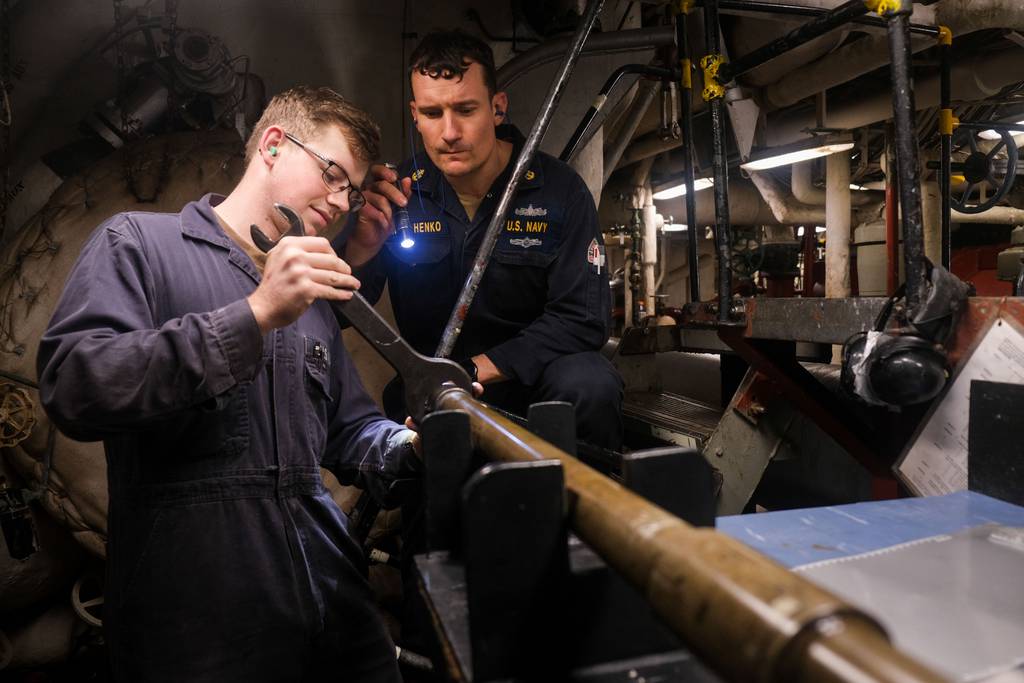
ARLINGTON, Va. — U.S. Fleet Forces Command is building a set of digital tools meant to increase ship readiness by helping leaders better direct resources and allowing individual sailors to tackle more complex repairs.
Adm. Daryl Caudle, who leads the command, said he wants to alter how the individual and the force approach ship maintenance and repairs.
“On a large scale, it’s going to empower these repair operation centers, maintenance operation centers, with a [common operating picture] that allows us to actually better see the material condition on the ships in real time,” he told Defense News at the annual Surface Navy Association conference.
With this new approach, sailors will continuously upload data about their ships as well as routine and emergency work — whereas previously the fleet got much of its information about ship conditions from casualty reports filed when something broke.
This data will feed into a dashboard for Caudle and his staff. While it won’t reduce the maintenance workload, it does let him “prioritize, target [and] understand what ship needs something. It gains my ability to have situational awareness so that I can help make the decisions of where to apply resources more effectively. So it overall improves fleet material readiness; that’s the goal.”
This is of particular importance to Caudle in light of conflicts in the Middle East and the potential for clashes elsewhere that could force the U.S. Navy to scramble forces forward. Caudle told reporters the service has about 100 ships deployed at any given time. He also said about 100 are in depot maintenance, and therefore unavailable. To him, this means the fleet must focus on the readiness of the remaining 100 or so that could deploy for a fight.
The surface fleet aims to have 75 mission-capable ships — meaning they’re ready for operations on short notice. A key component of this effort is reducing maintenance delays so ships can more quickly depart repair yards and get back to the waterfront.
Caudle said Fleet Forces Command is pursuing other efforts focused on the readiness of these potential “contingency response force” ships, including a push to get crews trained faster during the basic training phase.
Caudle also said his ongoing Fleet Maintenance Optimization effort will affect individual sailors, noting that when he joined the Navy, the submarine fleet had 16 submarine tenders that supported uniformed sailors conducting the bulk of submarine maintenance and repair work. The surface fleet was similarly maintained and repaired by sailors.
Today, civilians at naval shipyards and regional maintenance centers do much more of the work, with relatively few uniformed sailors who are proficient at maintenance, repair and troubleshooting, he said.
If the fleet is to keep itself at a higher state of readiness — being combat capable and able to receive repairs at sea — individual sailors need to learn more maintenance actions. To help move this along, Fleet Forces Command is creating digital packages that include drawings, instructions and videos that sailors can access from tablets. Much like a person who has never worked on cars can still change wiper blades with the help of online tutorials, Caudle wants sailors to be able to perform maintenance work they haven’t traditionally done in recent years.
Caudle said this will “fundamentally improve” sailors’ skills, “which will improve the readiness of the ship.”
“It will make people more likely to do [maintenance work] because they understand how to do it — all the way into high-level maintenance, corrective maintenance actions [on] bearings, electrical, component repairs,” he added.
Megan Eckstein is the naval warfare reporter at Defense News. She has covered military news since 2009, with a focus on U.S. Navy and Marine Corps operations, acquisition programs and budgets. She has reported from four geographic fleets and is happiest when she’s filing stories from a ship. Megan is a University of Maryland alumna.
- SEO Powered Content & PR Distribution. Get Amplified Today.
- PlatoData.Network Vertical Generative Ai. Empower Yourself. Access Here.
- PlatoAiStream. Web3 Intelligence. Knowledge Amplified. Access Here.
- PlatoESG. Carbon, CleanTech, Energy, Environment, Solar, Waste Management. Access Here.
- PlatoHealth. Biotech and Clinical Trials Intelligence. Access Here.
- Source: https://www.defensenews.com/naval/2024/01/09/fleet-forces-building-digital-tools-to-improve-repairs-sailor-skills/
- :has
- :is
- :where
- 100
- 11
- 16
- 2022
- 7
- 70
- 8
- a
- ability
- Able
- About
- access
- acquisition
- actions
- actually
- added
- affect
- aims
- aircraft
- All
- Allowing
- allows
- along
- also
- and
- Announcing
- annual
- any
- Apply
- approach
- ARE
- AS
- Association
- At
- awareness
- back
- basic
- BE
- because
- being
- Better
- Broke
- Budgets
- Building
- by
- CAN
- capable
- cars
- Centers
- change
- civilians
- combat
- Common
- complex
- component
- condition
- conditions
- conducting
- Conference
- conflicts
- continuously
- could
- covered
- Creating
- dashboard
- data
- decisions
- Defense
- delays
- deploy
- deployed
- digital
- direct
- do
- does
- done
- Drawings
- during
- East
- effectively
- effort
- efforts
- elsewhere
- emergency
- empower
- faster
- few
- fight
- filed
- Filing
- FLEET
- Focus
- focused
- For
- Force
- Forces
- Forward
- four
- from
- Gains
- geographic
- George
- get
- given
- goal
- going
- got
- had
- Have
- he
- help
- helping
- high-level
- higher
- him
- his
- How
- How To
- HTTPS
- i
- images
- importance
- improve
- improves
- in
- include
- Including
- Increase
- individual
- information
- instructions
- into
- IT
- ITS
- itself
- joined
- jpg
- june
- Keep
- Key
- large
- leaders
- Leads
- LEARN
- let
- light
- like
- likely
- maintenance
- make
- Marine
- Maryland
- material
- meaning
- means
- meant
- Megan
- Middle
- Middle East
- Military
- more
- move
- much
- must
- my
- Need
- needs
- never
- New
- news
- Notice..
- noting
- of
- on
- ongoing
- online
- operating
- operation
- Operations
- optimization
- or
- Other
- over
- overall
- packages
- particular
- People
- perform
- person
- phase
- picture
- plato
- Plato Data Intelligence
- PlatoData
- potential
- previously
- Programs
- pursuing
- Push
- quickly
- Readiness
- ready
- real
- real-time
- receive
- recent
- reduce
- reducing
- regional
- relatively
- remaining
- repair
- Reported
- reporter
- Reports
- Resources
- response
- routine
- s
- Said
- Scale
- SEA
- see
- service
- set
- she
- ship
- ships
- Short
- Similarly
- since
- skills
- So
- something
- Speaks
- Staff
- State
- Still
- Stories
- Supported
- Surface
- system
- tackle
- Target
- that
- The
- their
- therefore
- These
- they
- this
- time
- to
- told
- tools
- traditionally
- trained
- Training
- tutorials
- u.s.
- U.S. Navy
- understand
- university
- University of Maryland
- us
- Videos
- Visit
- W
- wants
- was
- Way..
- WELL
- What
- when
- whereas
- while
- WHO
- will
- with
- Work
- worked
- years
- zephyrnet

